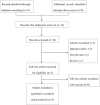Prognostic role of C-reactive protein in patients with nasopharyngeal carcinoma: A meta-analysis and literature review
- PMID: 29137033
- PMCID: PMC5690726
- DOI: 10.1097/MD.0000000000008463
Prognostic role of C-reactive protein in patients with nasopharyngeal carcinoma: A meta-analysis and literature review
Abstract
Background: C-reactive protein (CRP) has been shown to be associated with several tumors. However, its association with nasopharyngeal carcinoma (NPC) is not well characterized. We performed a literature review and meta-analysis to assess the prognostic relevance of elevated CRP levels in patients with NPC.
Methods: A literature search for relevant studies was performed on PubMed (Medline), the Cochrane Library, and Web of Science databases. Hazard ratios (95% confidence intervals) were calculated to assess the association between elevated CRP levels and survival outcomes.
Results: Five studies with a combined study population of 5215 patients with NPC were included. Pooled hazard ratios for overall survival and distant metastasis-free survival were 1.84 (95% CI = 1.57-2.17) and 1.81 (95% CI = 1.53-2.14), respectively. Subgroup analyses showed that types of indicators and treatment before inclusion had no significant impact on the observed association.
Conclusion: Elevated serum CRP levels in patients with NPC were associated with worse prognosis.
Conflict of interest statement
The authors report no conflicts of interest.
Figures




Similar articles
-
The prognostic value of C-reactive protein/albumin ratio in nasopharyngeal carcinoma: a meta-analysis.Biosci Rep. 2018 Nov 13;38(6):BSR20180686. doi: 10.1042/BSR20180686. Print 2018 Dec 21. Biosci Rep. 2018. PMID: 30352836 Free PMC article.
-
Prognostic value of pretreatment C-reactive protein/albumin ratio in nasopharyngeal carcinoma: A meta-analysis of published literature.Medicine (Baltimore). 2018 Jul;97(30):e11574. doi: 10.1097/MD.0000000000011574. Medicine (Baltimore). 2018. PMID: 30045284 Free PMC article.
-
Prognostic value of prognostic nutritional index in nasopharyngeal carcinoma: A meta-analysis containing 4511 patients.Oral Oncol. 2020 Nov;110:104991. doi: 10.1016/j.oraloncology.2020.104991. Epub 2020 Sep 9. Oral Oncol. 2020. PMID: 32919361
-
Prognostic role of pre-treatment serum albumin in patients with nasopharyngeal carcinoma: A meta-analysis and systematic review.Clin Otolaryngol. 2020 Mar;45(2):167-176. doi: 10.1111/coa.13454. Epub 2019 Dec 23. Clin Otolaryngol. 2020. PMID: 31573757
-
The Prognostic Role of Programmed Death-Ligand 1 in Nasopharyngeal Carcinoma.Laryngoscope. 2020 Nov;130(11):2598-2606. doi: 10.1002/lary.28523. Epub 2020 Feb 29. Laryngoscope. 2020. PMID: 32112431
Cited by
-
Prognostic impact of interleukin-6 and C-reactive protein on patients with breast cancer.Oncol Lett. 2019 Jun;17(6):5139-5146. doi: 10.3892/ol.2019.10183. Epub 2019 Mar 21. Oncol Lett. 2019. PMID: 31186728 Free PMC article.
-
Prognostic value of C-reactive protein in patients with glioma: a meta-analysis.Biomark Med. 2024;18(13-14):629-637. doi: 10.1080/17520363.2024.2380246. Epub 2024 Jul 31. Biomark Med. 2024. PMID: 39082387 Free PMC article. Review.
-
Prognostic and clinicopathological significance of C-reactive protein/albumin ratio (CAR) in patients with gastric cancer: A meta-analysis.PLoS One. 2021 Apr 26;16(4):e0250295. doi: 10.1371/journal.pone.0250295. eCollection 2021. PLoS One. 2021. Retraction in: PLoS One. 2022 Jun 24;17(6):e0270727. doi: 10.1371/journal.pone.0270727. PMID: 33901218 Free PMC article. Retracted.
-
Combination of sarcopenia and systemic inflammation-based markers for predicting the prognosis of patients undergoing pancreaticoduodenectomy for pancreatic cancer.PLoS One. 2024 Jun 24;19(6):e0305844. doi: 10.1371/journal.pone.0305844. eCollection 2024. PLoS One. 2024. PMID: 38913646 Free PMC article.
-
The prognostic value of C-reactive protein/albumin ratio in nasopharyngeal carcinoma: a meta-analysis.Biosci Rep. 2018 Nov 13;38(6):BSR20180686. doi: 10.1042/BSR20180686. Print 2018 Dec 21. Biosci Rep. 2018. PMID: 30352836 Free PMC article.
References
-
- Wee J, Ha TC, Loong S, et al. Is nasopharyngeal cancer really a “Cantonese cancer”? Chin J Cancer 2010;29:517–26. - PubMed
-
- Chua MLK, Wee JTS, Hui EP, et al. Nasopharyngeal carcinoma. Lancet 2016;387:1012–24. - PubMed
-
- Lu H, Peng L, Yuan X, et al. Concurrent chemoradiotherapy in locally advanced nasopharyngeal carcinoma: a treatment paradigm also applicable to patients in Southeast Asia. Cancer Treat Rev 2009;35:345–53. - PubMed
-
- Wolden SL, Chen WC, Pfister DG, et al. Intensity-modulated radiation therapy (IMRT) for nasopharynx cancer: update of the Memorial Sloan-Kettering experience. Int J Radiat Oncol Biol Phys 2006;64:57–62. - PubMed
-
- Gabay C, Kushner I. Acute-phase proteins and other systemic responses to inflammation. N Engl J Med 1999;340:448–54. - PubMed
Publication types
MeSH terms
Substances
LinkOut - more resources
Full Text Sources
Other Literature Sources
Research Materials
Miscellaneous

